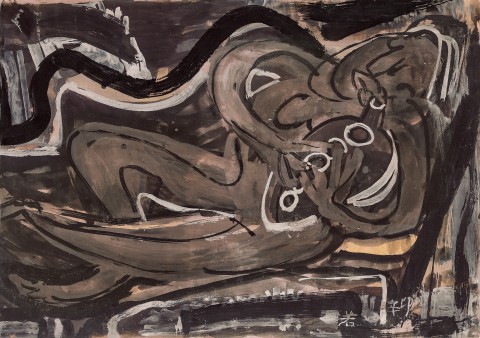MUSICIAN, 1951
IAN FAIRWEATHER
gouache on paper on composition board
47.5 x 67.5 cm
signed and dated lower right (in Chinese characters): IF 1951
Macquarie Galleries, Sydney
Robert Shaw, Sydney
Thence by descent
Private collection, Sydney
Exhibition of Paintings Easter 1953, Macquarie Galleries, Sydney, 31 March – 20 April 1953, cat. 7
Contemporary Australian Paintings from Private Collections in Sydney, Art Gallery of New South Wales, Sydney, 28 September – 19 October 1955, cat. 26 (as ‘Reclining Figure’)
Fairweather: a retrospective exhibition, Queensland Art Gallery, Brisbane, 3 June – 4 July 1965; Art Gallery of New South Wales, Sydney, 21 July – 22 August 1965; National Gallery of Victoria, Melbourne, 9 September – 10 October 1965; National Gallery of South Australia, Adelaide, 26 October – 21 November 1965; Western Australian Art Gallery, Perth, 9 December 1965 – 16 January 1966; Tasmanian Museum and Art Gallery, Hobart, 10 February – 13 March 1966, cat. 26 (as ‘Reclining Figure, about 1953?’)
Exhibition of the Private Collection of Robert Shaw Esq., Gallery A, Sydney, arranged by the exhibitions committee of the Art Gallery of New South Wales, 13 – 16 August 1966, cat. 22 (as ‘Lute Player, 1952’)
Art and Australia, Ure Smith, Sydney, Vol. 1, No. 1, May 1963, p.34 (illus. as ‘Lute Player (1949) Collection Robert Shaw’)
McGregor, C. (et. al), In the Making, Thomas Nelson, Melbourne, 1969, p. 147 (as ‘Reclining Figure’, image reversed)
Bail, M., Fairweather, Bay Books, Sydney & London, 1981, pl. 48, cat. 95, pp. 98, 106 (illus.), 238
By the time Ian Fairweather painted this voluptuous image, the British-born artist had already travelled through China, Bali, the Philippines, and India. The memories of these places, particularly of traditional village life, left tangible traces throughout his subsequent paintings. In spite of his self-imposed exclusion from society, Fairweather was fascinated with the lives of others, and his artworks are full of keenly observed imagery. However, it is the fusion of Eastern and Western painting styles that elevates his work. In the Australian canon, there was no one like him, and Musician, 1951, perfectly encapsulates all of these divergent influences.
Fairweather’s first solo exhibition was held at the Macquarie Galleries in Sydney in 1949, by which time he was living in Cairns. His biographer Murray Bail describes this residence as being ‘an abandoned goat dairy in a forest of lantana. Nearby was the skeleton of a sawmill; within the wall-less space, he constructed a studio.’1 This became a particularly fertile period for the artist as a multitude of images, mostly figurative, poured out of his brushes. A particular subject was his memories of the sub-continent and Fairweather painted ‘dozens of India-based kneeling figures where the brush describes not so much chaste forms as the rhythms of line (and so of life).’2 His nomadic spirit caused the artist to leave Cairns in late 1949, and he hitch-hiked to Darwin in early 1950, again setting up in the least likely of places, an abandoned railway truck. Driven out by possums and rats, Fairweather moved into the rear half of a wrecked patrol boat on Dinah Beach at Frances Bay; and here he stayed until the now infamous raft trip to Timor in April 1952. The figure was again central to the works created in Darwin and key works from 1950-51 include Persimmon (National Gallery of Victoria), Palm Sunday (Queensland Art Gallery), and the boldly evocative Pied-à-terre (Art Gallery of New South Wales). In Musician, 1951, the reclining androgynous figure defines the picture plane, eyes shut and engrossed within the music being coaxed from the gourd. This is a hand-made, even rudimentary instrument, which bears only passing resemblance to other gourd-based examples, such as the Indian pungi made famous by snake charmers. Fairweather allows the waves of music to animate the background, undulating lines that mimic the indulgent swell of the musician’s belly. The artist preferred painting at night by the light of kerosene lamps, and would start with a single mark, which would then be added to and amplified as memories, sounds and smells ignited his inspiration. Such a strategy can be determined in Musician, a sense that the image has emerged from the artist’s mind as he progressed. The palette is simple but the sensuous result is not.
Musician was not included in the artist’s exhibitions of 1951 and 1952, having already been purchased by the noted collector Robert Shaw. In 1953, Fairweather was ignominiously digging trenches in England, a result of his deportation from Timor. In the absence of new work, Shaw generously loaned Musician for exhibition at the Macquarie Galleries, thus allowing the creativity of this singular artist to remain in public view.
1. Bail, M., Ian Fairweather, Bay Books, Sydney & London, 1981, p.90
2. Ibid.
ANDREW GAYNOR
